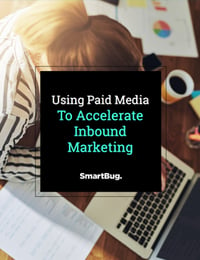
6 Ad Copywriting Best Practices to Get Your Audience Clicking
July 7, 2021
Getting someone to click on a paid ad in Google, Bing, Facebook, or any other paid marketing channel isn’t always easy. When developing a set of paid ads, remember that it’s far from a “set it and forget it” process. You need to constantly monitor and iterate on your ads, to test what’s working and what could be optimized with text changes or local phone number additions, for example. In this blog we’ll cover six copywriting best practices for creating paid media ads to capture the attention of your audience and have them click on your ad content.
1. Don’t be shy about what you offer.
One helpful tip for grabbing attention is to make a bold claim that stands out. Have you won any awards worth including? Do you have a product or service that no one else can claim? Staking a claim to what you’re good at is a good way to approach writing ads, and it will keep you focused on communicating what you do best to your audience.
At the end of the day, your ads need to stand out. Stand by your best products and services—and what makes you different—and share that with the world without fear.
2.Create a sense of urgency.
One way to drive action is to include time references in your ad, and expiration dates if needed, for time-based offers. Words like “today,” “this week,” or “ends Sunday” can all spark curiosity and interest from users and drive them to take action because of the time-sensitive offer.
The offer below doesn’t give a true end date, but does provide a sense of urgency by including the words “limited time sale,” which spark curiosity as to when the sale will end and drive users to take action before that date.
3. Address objections head-on.
When strategizing about ad types or the variations of ads you could create, remember to consider the questions people are asking about your product, service, or industry.
If you’re paying to put out an ad, remember that this is your chance to control the message. As opposed to earned media or word of mouth where you may not be able to control what is said about your company, paying to place your own ads gives you the chance to control what is said, and what is remembered about your brand.
Don’t be afraid to address objections head-on and proactively in your copy. This is your chance to make your audience more comfortable with your products and services and remove any objections or misconceptions they may have previously had.
4. Target local audiences.
It doesn't matter if you’re a single location or multi-location business, if you’re trying to optimize your paid media spend, you should have some ads that are written for local audiences. People like to support local, especially smaller businesses in close proximity to them. So in your copy, be sure to include local keywords, landmarks, and phone numbers to make your business more appealing to local communities.
The ad below from Coors targeted me in Wisconsin, which gave me a familiar feeling even though this ad was coming from a national beer brand.
5. Use video when possible.
If you’re paying to advertise on social media, it’s worth testing some branded video content. Sixty-four percent of consumers have purchased a product after watching branded social media content, and we’re continuing to see more ads in video format across platforms, and across our clients. Video captures our attention much more than still imagery, and it’s important to test branded video content if you have the capability to create it.
The video below caught my attention recently for a few reasons. First, it uses very simple copy that hints what the product is without telling you, creating some curiosity for the viewer. It then shows a short, fun video that captures your attention with the flamingo, and it ends by promoting Prairie Organic Spirits. It’s a simple video and even simpler copy, and it was enough to capture my attention.
6. Continually test your PPC ads.
Creating and launching your ads, gathering data, and testing new variations is the best way to continually improve your pay-per-click (PPC) advertising. Some of the ways you can test ad variations is via the following:
- Test different verbs and calls to action (CTAs) within your copy
- Test using different display URLs
- Test using numbers or symbols to help make your ad stand out
- Test copy length within the ad itself
- Test different services or products that you offer
- Test using different images within the ad
Get creative with your copywriting best practices.
Writing ad copy and optimizing paid marketing ads is not exactly a science, and it takes iterative testing to determine what works and what users will click on to help drive traffic to your site. Local targeting, addressing objections or misconceptions head-on, and calling out your product advantages are all copywriting best practices that can help get your audience to click on your ad.

About the author
Christopher Hutchens was formerly an E-commerce Marketing Strategist at SmartBug Media based in Salt Lake City. Originally from Chicago, Chris graduated from Mizzou and worked in Columbia, Missouri as an interactive project manager for five years before coming to SmartBug. Outside of work, Chris loves to travel, snowboard, and play/watch basketball. Read more articles by Christopher Hutchens.







